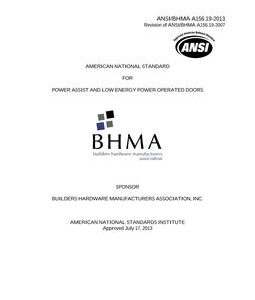Description
1.1 Requirements in this Standard apply only to swing door operators. The operator types are power assist, and low energy power operators, for pedestrian use, and some small vehicular use. It does not address doors, finish or hardware. The activation of all doors described in this standard requires a knowing act. Included are provisions intended to reduce the chance of user injury or entrapment.
1.2 Doors that require higher speeds, forces, shorter time delays, and activating sensing devices shall comply with ANSI/BHMA A156.10 for Power Operated Pedestrian Doors and are not covered in A156.19.
1.3 This Standard does not attempt to assess any factors that exist with respect to custom design installations which are not required to meet the requirements of this Standard.
1.4 Unless otherwise specified, all references to time delay, opening speed and forces in this standard, refer to the operator in the power mode as opposed to the manual mode.
1.5 Required dimensions are expressed in US units first and the SI (metric) equivalents given in parentheses are approximate. All values which do not carry specific tolerances or are not marked maximum or minimum shall have the following tolerances: Linear dimensions shall be ± 1/16 in (1.6 mm). Pounds or pound force shall be ± 5%. Angular measurements shall be ± 4 degrees. Voltage measurements shall be ± 5 percent. Temperature measurements shall be ± 4 degrees F (±2 degrees C).
1.6 Compliance with the requirements of this standard shall be accomplished through factory settings or field adjustments as necessary.
1.7 Operators used on labeled fire door assemblies shall be listed or labeled by a nationally recognized independent testing laboratory, and be subject to a periodic in-plant follow-up service. Consult the authority having jurisdiction for the appropriate fire test requirements.
Product Details
Published: 07/17/2013
ANSI Approved
Number of Pages: 11
File Size: 1 file , 250 KB







